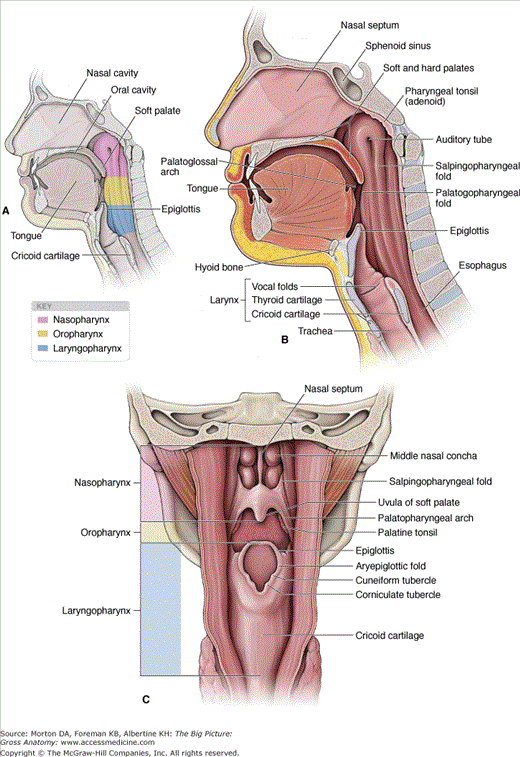Overview of the Pharynx
The pharynx is a funnel-shaped, fibromuscular tube that extends from the base of the skull to the cricoid cartilage, where the pharynx continues as the esophagus. The pharynx is commonly called the throat and serves as a common pathway for food and air.
The pharynx is classically divided into three compartments, based on location: the nasopharynx, the oropharynx, and the laryngopharynx (Figure 27-1A–C).
The nasopharynx is posterior to the nasal cavity, inferior to the sphenoid bone, and superior to the soft palate. During swallowing, the soft palate elevates and the pharyngeal wall contracts anteriorly to form a seal, preventing food from refluxing into the nasopharynx and nose. When we laugh, this sealing action can fail, and fluids that are being swallowed while we laugh can end up in the nasal cavity.
The nasopharynx is continuous with the nasal cavity through the arched openings called choanae. The auditory tubes, also known as the pharyngotympanic or eustachian tubes, connect the middle ear to the pharynx and open into the lateral walls of the nasopharynx. The auditory tubes allow middle ear pressure to equalize with atmospheric pressure.
The mucosa that lines the superior part of the posterior wall contains a ring of lymphatic tissue called the pharyngeal tonsil (adenoids), which traps and destroys pathogens that enter the nasopharynx in air (Figure 27-1B).
 When the pharyngeal tonsil (adenoids) is infected and swollen, it can completely block airflow through the nasal cavity so that breathing through the nose requires an uncomfortable amount of effort. As a result, inhalation occurs through an open mouth. Surgical removal of the adenoids (adenoidectomy) may be necessary if infections, earaches, or breathing problems become chronic.
When the pharyngeal tonsil (adenoids) is infected and swollen, it can completely block airflow through the nasal cavity so that breathing through the nose requires an uncomfortable amount of effort. As a result, inhalation occurs through an open mouth. Surgical removal of the adenoids (adenoidectomy) may be necessary if infections, earaches, or breathing problems become chronic.
Much of the mucosa of the nasopharynx posterior to the auditory tubes is supplied by the pharyngeal branch of cranial nerve (CN) V-2 (maxillary nerve), which traverses the palatovaginal canal with the pharyngeal branch of the maxillary artery.
The oropharynx is the region of the pharynx located between the soft palate and the epiglottis and communicates with the oral cavity. The palatoglossal arches mark the boundary between the oral cavity anteriorly and the oropharynx posteriorly. The posterior third of the tongue forms a partial anterior wall of the oropharynx. The mucosa of the oropharynx and the posterior third of the tongue are innervated by the glossopharyngeal nerve (CN IX).
The laryngopharynx extends between the epiglottis and the cricoid cartilage, with the larynx forming the anterior wall. The laryngopharynx serves as a common passageway for food and air. The laryngopharynx communicates posteriorly with the esophagus, where food and fluids to the stomach pass (Figure 27-1B and C). In addition, the laryngopharynx communicates anteriorly with the larynx, where air is conducted in and out of the lungs during breathing. During swallowing, food has the “right of way” and air passage stops temporarily. Innervation of the mucosa of the laryngopharynx is provided by the vagus nerve (CN X).
Functions of the Pharynx




